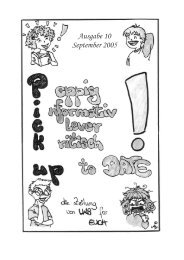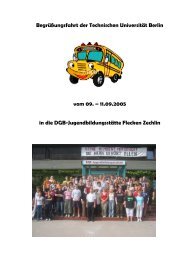Elegantes Telefax - JAV der TUB - TU Berlin
Elegantes Telefax - JAV der TUB - TU Berlin
Elegantes Telefax - JAV der TUB - TU Berlin
You also want an ePaper? Increase the reach of your titles
YUMPU automatically turns print PDFs into web optimized ePapers that Google loves.
27<br />
breaking the stalemate of dam construction (WCD 2000, 26; Witte et al 2000,<br />
McCully 2001, 1468). The potential deal between the World Bank and the critical<br />
NGOs of accepting stricter standards and granting/receiving higher acceptance did<br />
not materialize as it became clear already during the selection process of the commissioners<br />
(Dubash et al 2001, 39; McCully 2001, 1470). After the WCD had published<br />
its report in 2000, the World Bank did not adopt its conclusions and the NGOs<br />
remained as opposed to the financing of large dams as before.<br />
VIII.<br />
EVALUATING THE IMPACT OF THE 1993 WATER RE-<br />
SOURCES MANAGEMENT POLICY PAPER IN 2002<br />
There is no independent analysis of the impact of the policy change that was introduced<br />
by the 1993 Water Resource Management Policy Paper. To get an impression<br />
one has to rely on the internal evaluation of the World Bank. The OED evaluation<br />
of the implementation of the 1993 Water Resource Management Policy Paper<br />
was a multi-year effort, approved by the Board of Directors Committee on Development<br />
Effectiveness (CODE). Starting in 1998, it is based on a comparison of a sixyear<br />
period prior (1988-1993) and six years after the beginning of the Water Resources<br />
Management Policy (1994-1999) by covering all and completed water projects<br />
and projects with water components. It was based on the desk evaluation of<br />
410 projects and numerable analytical activities, the in-depth review of four countries,<br />
thematic studies (later cancelled) and a survey of World Bank staff. In addition workshops<br />
were held within the Bank and with stakehol<strong>der</strong>s in borrowing countries to discuss<br />
methods and progress (World Bank 2002b). The draft report was discussed with<br />
stakehol<strong>der</strong>s in a forum organized by the Water Resources Management Group. The<br />
main result has been that the 1993 Water Resource Management Policy Paper has<br />
been implemented broadly, but only partially and unevenly. The implementation varied<br />
widely across regions, countries and water sub-sectors. In water supply and environment,<br />
there has been consi<strong>der</strong>able progress, but less so in irrigation: There have<br />
been changes on a project level, but there the impetus for policy changes has been<br />
limited, as well as in country analytic work.<br />
The portfolio of the Bank has been responsive to the impetus of the 1993 Water<br />
Resource Management Policy Paper: Economic and sector work has increased consi<strong>der</strong>ably<br />
and dealt more with policy issues and less with the traditional technical topics<br />
(World Bank 2002b, 8). There has been an increase in commitments for water<br />
lending after 1993, but it lasted only until 1997 when it declined. Its sub-sectoral<br />
composition shifted from the traditional service sectors, water supply and sanitation





